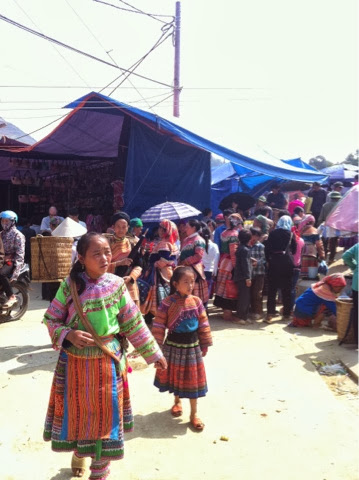Bac Ha is a small town north east of Sa pa, North Vietnam. It is 200km south of China. We decided to visit as it has a reputation for being like Sa pa except less spoilt - more authentic. We had an awesome meal at a local Tay family and after a night's rest at their homestay we were ready for a trek. Trang, our guide took us on a 6 hour hike through the surrounding mountains and villages, telling us about the local culture and customs along the way.
Looking at the Hmong tribes we'd noticed that they had really distinct facial features and skin colours - different to your average vietnamese. Trang explained - they migrated to Vietnam following tensions in China 200 years ago, setting up farming villages. Their languages are similar to Chinese and so is their script, but due to french influence latin script is the most visible in Vietnam today. Men and women both share the workload beginning at about 10 years old. No one owns a particular piece of land - everyone shares. The relationship between man and animal is really cool to see. As we walked through a village, a hen with 10 chicks paraded up a nearby mound. Cats and dogs foraged whilst piglets ran their little legs away at the sight of us. We might find a pest-spider in our bathtub in the UK, in Bac Ha we found a horse cheekily nibbling on a spread of dry corn put out for chickens, only to be chased away by a little girl with a stick! Across an open expanse a couple of buffalos peeked out to see what was going on, scuttling away as we approached.
The various Hmong tribes are identified by their clothing. You have the black Hmong like Cho Cho in Sa pa, but there are very few in Bac Ha. The most visible Hmong tribe in Bac ha is the flower Hmong who wear really bright colourful clothing. You also get red Hmong and white Hmong.
We were really happy to see how animals were treated there. Everything roams free, beasts of burden are burdened within their capacity and animals eat what is natural for them. The village life is symbiotic and harmonious, streams of life flowing through and around each other without clashing, everything fitting effortlessly. Wastage is kept to a minimum, for example rice straw makes good buffalo feed, rice and corn husks are burnt for cooking. This is not the mathematical perfection of the city, where perfection is geometric equality, the movement of heavenly bodies replaced by mechanical clocks and human worth measured as efficiency in the workplace. It is a natural perfection where everything fits seamlessly and sustainably and has stood the test of time, for only an illusory perfection can be short lived.
Unfortunately as is the case throughout the world the peaceful villagers of Bac ha are facing the demands of large corporations with no choice but to conform. The lush hills of Bac ha are being mined for stone, dynamite blasts 11 times a day leaving an ugly open wound in the countryside. Farm land is taken by force for the relentless pursuit of stone and no compensation is offered to the villagers.
The morning before we left Bac Ha we visited the local sunday market. Thus is where once a week various hill tribes of Bac Ha come together to sell their produce. It is a rich cultural experience as the various hmong women come out in full force with their dress, selling everything from clothing to livestock. Have a look at these pictures:



No comments:
Post a Comment